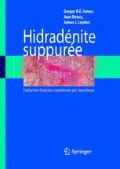Abstrait
-
Les lésions d’hidradénite s’étendent dans la profondeur des tissus.
-
L’imagerie permet de faciliter l’évaluation de la sévérité de la maladie, ainsi que le traitement.
-
L’imagerie peut aider au diagnostic différentiel.
Preview
Unable to display preview. Download preview PDF.
Références
Jemec GBE, Gniadecka M (1997) Ultrasound examination of hair follicles in hidradenitis. Arch Dermatol 133: 967–72
Holm EA, Wortsman X, Gniadecka M (2004) Real Time Spatial Compound imaging of skin and skin lesions Skin Res Technol 10: 23–31
Kelly AM, Cronin P (2005) MRI features of hidradenitis suppurativa and review of the literature. AJR Am J Roentgenol 185: 1201–4
Cuenod CA, de Parades V, Siauve N (2003) MR imaging of ano-perineal suppurations. J Radiol 84: 516–28
Nagdir R, Rubesin SE, Levine MS (2001) Perirectal sinus tracks and fistulas caused by hidradenitis suppurativa. AJR Am J Roentgenol 177(2): 476–7
Author information
Authors and Affiliations
Rights and permissions
Copyright information
© 2008 Springer-Verlag France, Paris,
About this chapter
Cite this chapter
Wortsman, X., Jemec, G.B.E. (2008). Imagerie. In: Hidradénite suppurée. Springer, Paris. https://doi.org/10.1007/978-2-287-72063-5_5
Download citation
DOI: https://doi.org/10.1007/978-2-287-72063-5_5
Publisher Name: Springer, Paris
Print ISBN: 978-2-287-72062-8
Online ISBN: 978-2-287-72063-5

